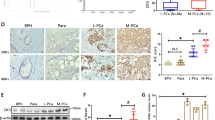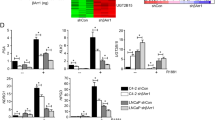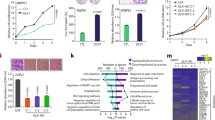Abstract
The multifunctional protein Yin Yang 1 (YY1) has an important role in epigenetic regulation of gene expression. YY1 is highly expressed in various types of cancers, including prostate cancer. Currently, the mechanism underlying the functional role of YY1 in prostate tumorigenesis remains unclear. In this report, we investigated the functional interplay between YY1 and androgen receptor (AR), and the effect of YY1 on AR-mediated transcription. We found that YY1 physically interacts with AR both in a cell-free system and in cultured cells. YY1 is required for the optimal transcriptional activity of AR in promoting the transcription of the prostate-specific antigen (PSA) promoter. However, ectopic YY1 expression in LNCaP cells did not further enhance the reporter driven by the PSA promoter, suggesting that an optimal level of YY1 is already established in prostate tumor cells. Consistently, YY1 depletion in LNCaP cells reduced endogenous PSA levels, but overexpressed YY1 did not significantly increase PSA expression. We also observed that YY1–AR interaction is essential to YY1-mediated transcription activity of AR and YY1 is a necessary component in the complex binding to the androgen response element. Thus, our study demonstrates that YY1 interacts with AR and regulates its transcriptional activity.
This is a preview of subscription content, access via your institution
Access options
Subscribe to this journal
Receive 50 print issues and online access
$259.00 per year
only $5.18 per issue
Buy this article
- Purchase on Springer Link
- Instant access to full article PDF
Prices may be subject to local taxes which are calculated during checkout








Similar content being viewed by others
References
Bain M, Sinclair J . (2005). Targeted inhibition of the transcription factor YY1 in an embryonal carcinoma cell line results in retarded cell growth, elevated levels of p53 but no increase in apoptotic cell death. Eur J Cell Biol 84: 543–553.
Baritaki S, Sifakis S, Huerta-Yepez S, Neonakis IK, Soufla G, Bonavida B et al. (2007). Overexpression of VEGF and TGF-beta1 mRNA in Pap smears correlates with progression of cervical intraepithelial neoplasia to cancer: implication of YY1 in cervical tumorigenesis and HPV infection. Int J Oncol 31: 69–79.
Begon DY, Delacroix L, Vernimmen D, Jackers P, Winkler R . (2005). Yin Yang 1 cooperates with activator protein 2 to stimulate ERBB2 gene expression in mammary cancer cells. J Biol Chem 280: 24428–24434.
Bracken AP, Pasini D, Capra M, Prosperini E, Colli E, Helin K . (2003). EZH2 is downstream of the pRB-E2F pathway, essential for proliferation and amplified in cancer. EMBO J 22: 5323–5335.
Caretti G, Di Padova M, Micales B, Lyons GE, Sartorelli V . (2004). The Polycomb Ezh2 methyltransferase regulates muscle gene expression and skeletal muscle differentiation. Genes Dev 18: 2627–2638.
Cleutjens KB, van der Korput HA, van Eekelen CC, van Rooij HC, Faber PW, Trapman J . (1997). An androgen response element in a far upstream enhancer region is essential for high, androgen-regulated activity of the prostate-specific antigen promoter. Mol Endocrinol 11: 148–161.
Craft N, Chhor C, Tran C, Belldegrun A, DeKernion J, Witte ON et al. (1999). Evidence for clonal outgrowth of androgen-independent prostate cancer cells from androgen-dependent tumors through a two-step process. Cancer Res 59: 5030–5036.
de Nigris F, Botti C, de Chiara A, Rossiello R, Apice G, Fazioli F et al. (2006). Expression of transcription factor Yin Yang 1 in human osteosarcomas. Eur J Cancer 42: 2420–2424.
Dehm SM, Tindall DJ . (2005). Regulation of androgen receptor signaling in prostate cancer. Expert Rev Anticancer Ther 5: 63–74.
Deng Z, Wan M, Sui G . (2007). PIASy-mediated sumoylation of Yin Yang 1 depends on their interaction but not the RING finger. Mol Cell Biol 27: 3780–3792.
Erkeland SJ, Valkhof M, Heijmans-Antonissen C, Delwel R, Valk PJ, Hermans MH et al. (2003). The gene encoding the transcriptional regulator Yin Yang 1 (YY1) is a myeloid transforming gene interfering with neutrophilic differentiation. Blood 101: 1111–1117.
Gaddipati JP, McLeod DG, Heidenberg HB, Sesterhenn IA, Finger MJ, Moul JW et al. (1994). Frequent detection of codon 877 mutation in the androgen receptor gene in advanced prostate cancers. Cancer Res 54: 2861–2864.
Galvin KM, Shi Y . (1997). Multiple mechanisms of transcriptional repression by YY1. Mol Cell Biol 17: 3723–3732.
Gill G, Ptashne M . (1988). Negative effect of the transcriptional activator GAL4. Nature 334: 721–724.
Gioeli D, Ficarro SB, Kwiek JJ, Aaronson D, Hancock M, Catling AD et al. (2002). Androgen receptor phosphorylation. Regulation and identification of the phosphorylation sites. J Biol Chem 277: 29304–29314.
Gregory CW, Johnson Jr RT, Mohler JL, French FS, Wilson EM . (2001). Androgen receptor stabilization in recurrent prostate cancer is associated with hypersensitivity to low androgen. Cancer Res 61: 2892–2898.
Gronroos E, Terentiev AA, Punga T, Ericsson J . (2004). YY1 inhibits the activation of the p53 tumor suppressor in response to genotoxic stress. Proc Natl Acad Sci USA 101: 12165–12170.
Gross M, Yang R, Top I, Gasper C, Shuai K . (2004). PIASy-mediated repression of the androgen receptor is independent of sumoylation. Oncogene 23: 3059–3066.
Heinemeyer T, Wingender E, Reuter I, Hermjakob H, Kel AE, Kel OV et al. (1998). Databases on transcriptional regulation: TRANSFAC, TRRD and COMPEL. Nucleic Acids Res 26: 362–367.
Heinlein CA, Chang C . (2004). Androgen receptor in prostate cancer. Endocr Rev 25: 276–308.
Hirawat S, Budman DR, Kreis W . (2003). The androgen receptor: structure, mutations, and antiandrogens. Cancer Invest 21: 400–417.
Joshi B, Rastogi S, Morris M, Carastro LM, DeCook C, Seto E et al. (2007). Differential regulation of human YY1 and caspase 7 promoters by prohibitin through E2F1 and p53 binding sites. Biochem J 401: 155–166.
Koivisto P, Kononen J, Palmberg C, Tammela T, Hyytinen E, Isola J et al. (1997). Androgen receptor gene amplification: a possible molecular mechanism for androgen deprivation therapy failure in prostate cancer. Cancer Res 57: 314–319.
Lapouge G, Erdmann E, Marcias G, Jagla M, Monge A, Kessler P et al. (2007). Unexpected paracrine action of prostate cancer cells harboring a new class of androgen receptor mutation--a new paradigm for cooperation among prostate tumor cells. Int J Cancer 121: 1238–1244.
Rao A, Chang BL, Hawkins G, Hu JJ, Rosser CJ, Hall MC et al. (2003). Analysis of G/A polymorphism in the androgen response element I of the PSA gene and its interactions with the androgen receptor polymorphisms. Urology 61: 864–869.
Rubinson DA, Dillon CP, Kwiatkowski AV, Sievers C, Yang L, Kopinja J et al. (2003). A lentivirus-based system to functionally silence genes in primary mammalian cells, stem cells and transgenic mice by RNA interference. Nat Genet 33: 401–406.
Rylski M, Amborska R, Zybura K, Mioduszewska B, Michaluk P, Jaworski J et al. (2008). Yin Yang 1 is a critical repressor of matrix metalloproteinase-9 expression in brain neurons. J Biol Chem 283: 35140–35153.
Santiago FS, Ishii H, Shafi S, Khurana R, Kanellakis P, Bhindi R et al. (2007). Yin Yang-1 inhibits vascular smooth muscle cell growth and intimal thickening by repressing p21WAF1/Cip1 transcription and p21WAF1/Cip1-Cdk4-cyclin D1 assembly. Circ Res 101: 146–155.
Seligson D, Horvath S, Huerta-Yepez S, Hanna S, Garban H, Roberts A et al. (2005). Expression of transcription factor Yin Yang 1 in prostate cancer. Int J Oncol 27: 131–141.
Sharifi N, Farrar WL . (2006). Androgen receptor as a therapeutic target for androgen independent prostate cancer. Am J Ther 13: 166–170.
Shenk JL, Fisher CJ, Chen SY, Zhou XF, Tillman K, Shemshedini L . (2001). p53 represses androgen-induced transactivation of prostate-specific antigen by disrupting hAR amino- to carboxyl-terminal interaction. J Biol Chem 276: 38472–38479.
Shi Y, Lee JS, Galvin KM . (1997). Everything you have ever wanted to know about Yin Yang 1. Biochim Biophys Acta 1332: F49–F66.
Sui G, Affar el B, Shi Y, Brignone C, Wall NR, Yin P et al. (2004). Yin Yang 1 is a negative regulator of p53. Cell 117: 859–872.
Sui G, Shi Y . (2005). Gene silencing by a DNA vector-based RNAi technology. Methods Mol Biol 309: 205–218.
Sui G, Soohoo C, Affar el B, Gay F, Shi Y, Forrester WC et al. (2002). A DNA vector-based RNAi technology to suppress gene expression in mammalian cells. Proc Natl Acad Sci USA 99: 5515–5520.
Tannous BA, Kim DE, Fernandez JL, Weissleder R, Breakefield XO . (2005). Codon-optimized Gaussia luciferase cDNA for mammalian gene expression in culture and in vivo. Mol Ther 11: 435–443.
Taplin ME, Bubley GJ, Ko YJ, Small EJ, Upton M, Rajeshkumar B et al. (1999). Selection for androgen receptor mutations in prostate cancers treated with androgen antagonist. Cancer Res 59: 2511–2515.
Thomas MJ, Seto E . (1999). Unlocking the mechanisms of transcription factor YY1: are chromatin modifying enzymes the key? Gene 236: 197–208.
Veldscholte J, Berrevoets CA, Ris-Stalpers C, Kuiper GG, Jenster G, Trapman J et al. (1992). The androgen receptor in LNCaP cells contains a mutation in the ligand binding domain which affects steroid binding characteristics and response to antiandrogens. J Steroid Biochem Mol Biol 41: 665–669.
Wang H, Hertlein E, Bakkar N, Sun H, Acharyya S, Wang J et al. (2007). NF-kappaB regulation of YY1 inhibits skeletal myogenesis through transcriptional silencing of myofibrillar genes. Mol Cell Biol 27: 4374–4387.
Wilkinson FH, Park K, Atchison ML . (2006). Polycomb recruitment to DNA in vivo by the YY1 REPO domain. Proc Natl Acad Sci USA 103: 19296–19301.
Yang WM, Inouye C, Zeng Y, Bearss D, Seto E . (1996). Transcriptional repression by YY1 is mediated by interaction with a mammalian homolog of the yeast global regulator RPD3. Proc Natl Acad Sci USA 93: 12845–12850.
Yao YL, Yang WM, Seto E . (2001). Regulation of transcription factor YY1 by acetylation and deacetylation. Mol Cell Biol 21: 5979–5991.
Acknowledgements
We thank Dr Purnima Dubey and Ms Karen Klein for critical reading of the article. We also thank Dr Suzy Torti and Dr Wei Wang for providing the access to some equipment, and Dr Kazushi Inoue for the EMSA protocol. The support for the work came from the grant of American Cancer Society (RSG-09-082-01-MGO) and the startup fund from the Department of Cancer Biology and Comprehensive Cancer Center of Wake Forest University to GS. PC is supported by NCI training Grant 5T32CA079448-09.
Author information
Authors and Affiliations
Corresponding author
Additional information
Supplementary Information accompanies the paper on the Oncogene website (http://www.nature.com/onc)
Supplementary information
Rights and permissions
About this article
Cite this article
Deng, Z., Wan, M., Cao, P. et al. Yin Yang 1 regulates the transcriptional activity of androgen receptor. Oncogene 28, 3746–3757 (2009). https://doi.org/10.1038/onc.2009.231
Received:
Revised:
Accepted:
Published:
Issue Date:
DOI: https://doi.org/10.1038/onc.2009.231
Keywords
This article is cited by
-
G-quadruplexes promote the motility in MAZ phase-separated condensates to activate CCND1 expression and contribute to hepatocarcinogenesis
Nature Communications (2024)
-
MicroRNA-140 impedes DNA repair by targeting FEN1 and enhances chemotherapeutic response in breast cancer
Oncogene (2020)
-
Convergent network effects along the axis of gene expression during prostate cancer progression
Genome Biology (2020)
-
Mycobacterial HelD is a nucleic acids-clearing factor for RNA polymerase
Nature Communications (2020)
-
DCYTB is a predictor of outcome in breast cancer that functions via iron-independent mechanisms
Breast Cancer Research (2017)



